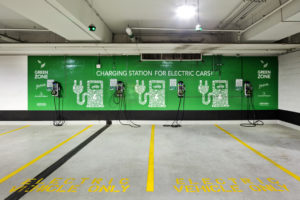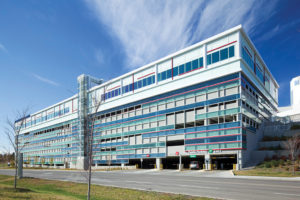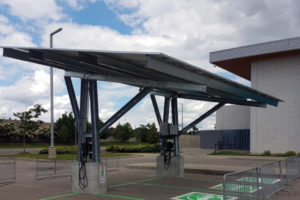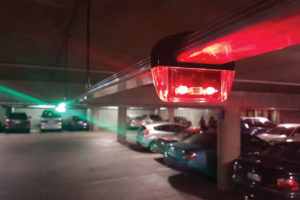By Ralph Bond
It seems that almost every week there is a news article about how the fast approaching world of autonomous vehicles (AV’s) will change the way we travel, impact on transportation related infrastructure – especially parking, and influence planning and design for urban real estate development. There is a wide divergence of opinion on when and how the impacts might occur and many unsubstantiated pronouncements. Nevertheless, an increasing number of developers as well as public sector agencies and municipalities are becoming concerned about the potential impacts and the risks associated with building new infrastructure that may not be suitable for the future.
The increased use of ride hailing services like Uber and Lyft is already reducing parking demand in varying degrees. For example, hotels in urban areas are reporting substantial reductions in parking demand because people are increasingly using ride-hailing services in place of rental cars. Some airports are also reporting significant declines in parking demand. More business people are using ride-hailing services in place of driving in some congested urban areas because it allows them to work while travelling and avoid the frustration of finding a parking space. Although these examples do not apply universally, it is an indication of how business related travel is changing when it comes to mobility in congested urban areas. We therefore prefer to think of the issue as the increased use of ride hailing services whether they are in autonomous vehicles or not.
Increasingly, both the public and private sector are asking questions such as:
- Do we really need this much parking?
- What is the risk that we will be stuck with a stranded parking asset?
- Can parking be designed for conversion to another use to mitigate the risk?
- Can increased use of shared public parking mitigate future risk?
- Will a lot more…
By Jennifer Mucha
Toronto Pearson is Canada’s largest airport, and the ninth-busiest airport in North America, moving nearly 50 million annual passengers from security checkpoint to gate to more than 170 destinations around the world. The airport has a mandate to put passengers at the heart of every decision, and as a result was recently recognized by the Airports Council International as the Airport Service Quality best large airport in North America. Believing that the passenger experience starts long before take-off, Toronto Pearson is using technology and analytics to build a diverse and creative transportation offering that ensures travellers have an end-to-end experience tailored to their individual needs, while keeping future aviation demand in its sights.
Toronto Pearson has come a long way from its origins in a farmer’s field in the village of Malton in 1939. The airport grounds now stretch from Mississauga in the west to the city of Toronto in the east and south, and to Brampton in the north. At the heart of three municipalities and close to the 400-series highways, it goes without saying that Toronto Pearson sees high vehicle traffic from passengers, meeters, greeters and employees.
Integrating Parking and Transportation
With nearly 50 million annual passengers, as well as an airport employee community of almost 50,000 workers, efficient transportation into and out of the airport is critical to the success of the operation. An intricate network of municipal transit providers, ground transportation operators and the airport’s own Parking and Ground Transportation business unit work together with a common goal: to ensure that transportation at the airport is integrated, provides a diverse and appropriate range of services and contributes to the airport’s passengers-first mandate.
Achieving that goal is no small feat. Toronto Pearson’s three covered garages and two outdoor lots represent Canada’s…
By Mark Hutchinson, Vice President of Green Building Programs, Canada Green Building Council
The changing nature of the parking and transportation industry has highlighted the importance of understanding the sector’s environmental impact and its key role in mitigating climate change. Among those leading the charge in this area is the Yorkdale Shopping Centre in Toronto’s North York area, which has been no stranger to innovative new initiatives throughout its 50-year history, including a number of sustainability efforts as part of its green program.
In July 2018, the mall achieved Parksmart certification at the Pioneer level for existing parking structures by obtaining more than 90 points for its G Parkade southwest parking garage, and in August, Yorkdale’s newly constructed E Parkade east structure certified Parksmart Bronze by achieving between 110 and 134 points. These are the first Parksmart certified projects in Canada – and the first retail certifications in the world.
The Parksmart rating system is administered in Canada by GBCI Canada, which is jointly-owned by the Canada Green Building Council (CaGBC) and Green Business Certification Inc. (GBCI). Designed to advance sustainable mobility through smarter parking structure design and operation, Parksmart helps parking structure owners and managers ensure their assets are future-proof and functioning optimally in order to maximize operational savings.
For both Yorkdale projects, the Parksmart certification process has served to highlight opportunities to maximize and modernize parking assets, ensure strong returns on investment, and provide an enhanced parking experience for mall patrons.
Redefining parking as part of a broader green strategy
Yorkdale has had green initiatives in place for more than two decades, from being one of the first shopping centres in Canada to implement a recycling program, to more recent measures such as the utilization of reusable tableware and cutlery, organics composting and an urban…
By Chris Davis, BSc, P.Eng., CEng, MICE, MIStructE, LEED® AP | Principal, RJC Engineers
The right parking plan is critical to the success of a parkade project – it strongly influences the budget and ultimately, the long term success for the owner. Determining an optimal plan requires careful, thoughtful design with experience and expertise in parking planning, but it also requires a fundamental understanding of how structural systems are integrated. The ideal solution provides a highly functional layout within an economical and easily constructed building.
No two buildings are ever the same. In order to meet the vast range of challenges that are presented throughout any given project, parking structure designers need to understand the objectives of their clients and the demands of the industry before beginning the design of a building. If they fully understand what the requirements and priorities are, they are better equipped to develop an optimal solution that can perform a range of functions – taking into account current and future uses.
Our industry is facing the impending probability that the presence and use of motor vehicles will soon be seeing major changes. With these changes, we will see the inevitable reduced demand for parking structures as we know them today. The parking industry, understandably, is starting to reconsider how parkades should be constructed for the future, with design life to structural codes of a minimum of 50 years. It is unlikely that many of the parkades we build today will be used in the same way in 50 years’ time. So, how do we make these purpose-built, one-function structures suitable for future use, when it’s so difficult to predict what they will need to do?
TRADITIONAL PARKING DESIGNS
Parking planning involves the efficient layout of traffic flow (entries, exits, circulation, etc.) and stalls within a given footprint. Developing the…
By Jay Boychuk and Lisa Oelke, hb Solar Canada
Parking lots are assets for those that charge for the spaces within them, or need them to attract customers or even employees. They serve one main purpose, to provide a place to leave cars, whether it is for an hour, or a day. What if that asset could be turned into a multi-purpose piece of land that not only provides parking, but generates additional cashflow, and helps the environment? Parking lots can do a surprising thing, they can generate electricity, and not only that, its green energy. Introducing solar covered parking can do just that.
Why would a parking lot operator want to be a producer of green energy? Large cities can have a tremendous amount of asphalt covered surfaces, some above 40% of their land mass. Suburban areas don’t escape these large amounts of asphalt coverage either. A lot of that density is roadways, with surface parking lots significantly adding to the total as well. What does all this asphalt do to our environment if we just use it for parking cars?
When it comes to identifying the greatest challenge to meeting Green House Gas (GHG) reductions, transportation leads in Ontario as the single-largest emitting sector in the economy at 35%. In response to these statistics, the Ontario Government is encouraging drivers to switch to electric vehicles, (EV’s) by offering rebates of up to $14,000 with the purchase of an EV. Quebec and B.C. have similar statistics and have also offered incentives. The Electric Vehicle Chargers Ontario(EVCO) incentive serves to increase access to charging stations with funding to build a network of fast-charging EV stations in cities, along highways, at workplaces, apartments, condos, and public places across Ontario. These measures create demand for additional EV charging in locations where cars need
to park…
By Chelsea Webster, ParkPlus System
The world must be ending; casinos in Las Vegas are making it the norm to charge for parking1. In life, there are very few guarantees – but free parking at a casino in Vegas, or at your neighborhood Walmart, seemed like one of them. No, I’m not saying WalMart is starting to charge for parking (although I will address this opportunity below). But maybe they should.
This article is about the copious amounts of free parking that presents itself at nearly every big box retail store across North America. It’s commonplace, but does it make common sense?
I’m going to propose that Walmart is one of the most iconic, prevalent, and effective of all big box stores. As such, I’ll use them as an example of how most of this type of retailer tackles parking management.
In Calgary, there are 11 Walmart locations. Each of these locations offer roughly the same amount (if not more) of square footage for parking as there is shopping/interior of the building. Here are a few images (thanks Google maps) to illustrate what I’m saying:

You’ll also notice something else in these images – a LOT of parking stalls without vehicles parked in them. So, why would Walmart, a very savvy retailer, opt to purchase all of that land and designate it for unused parking?
There are several answers to this question, and they vary depending on which location you’re looking at. A few common reasons are:
Mandatory minimums: Some municipalities force builders to include a certain number of parking stalls per square foot of space.
Profit maximization: You’d never want a customer to leave without coming into the store because they couldn’t find parking.
Peak demand: The lot must be able to accommodate every single shopper at the busiest…
Parking Excellence Recognized in Canada (PERC), later updated to the Parking Facility Standards Award program (PFSA) was the first parking facility evaluation program of its kind, and saw many Canadian parking organizations achieve success through participation in the program.
Derived from these past award programs, a standard checklist of items required to meet acceptable, minimum standards for a parking facility has been further amended and endorsed by the Canadian Parking Association as the benchmark for measuring a facility against national standards.
The objective of sharing this check list is to provide the tools necessary for operators to self-check their parking facilities against minimum requirements to manage and maintain a quality parking operation that sets it above others, and helps to improve the image of the industry. The standards cover a variety of facility types, from gravel lots to state-of-the-art parkades, both old and new.
Through a comprehensive consultative process involving a team of parking professionals representing the municipal, airport, campus, private, and hospital sectors, a set of criteria emerged. The CPA’s Image Committee, comprised of board members from all Canadian sectors, worked in consultation with members from all regions of the country during various stages of development.
Focus groups were conducted in five major cities across Canada: Vancouver, Calgary, Toronto, Montreal and Saint John. More than 300 participants from a range of community sectors were asked to share current and relevant information about their experiences using parking facilities.
Keeping in mind that this study was conducted prior to the technological boom that has evolved and transformed the industry over the past decade, the study’s main focus at the time was on the physical state of the parking facilities and the level of customer service provided to enhance the parking experience. Despite the development and introduction of new technology, maintaining standards in all aspects of…
By Bill Smith
We live in a time of great change when it comes to parking. The industry has been revolutionized in recent years by the development of many new technologies that are designed to make parking more customer-friendly, while at the same time benefitting owners and operators by making operations more manageable. These technological advances have transformed the ways owners and operators manage their parking assets, and they’ve even changed the ways drivers approach parking.
Today, we are on the cusp of another technological revolution that will carry extraordinary implications for the parking industry. The age of connected and self-driving vehicles will soon be in full bloom and each will present a host of challenges and opportunities. While these future vehicles may seem like the stuff of science fiction, it won’t be long before each plays an important role in our transportation system.
Getting Connected
The connected vehicle is already well on its way to becoming a reality. In just a few years all new cars will have vehicle infrastructure communications and will be connected to the grid. Our vehicles will be able to communicate with traffic technology and recommend which routes to take to avoid congestion and reach our destinations more quickly. They will also take us right to available parking spaces and automatically pay for the exact amount of time we need to park.
According to Nigel Bullers, CEO of EasyPark in Vancouver, the primary challenge for operators and municipal parking managers is forecasting what future connected cars will be able to do. He says that, ultimately, there will need to be a meeting of the minds between what auto manufacturers think their smart cars should do and what consumers actually want.
“It’s not as easy as it may seem to predict what features will be present and how operators and municipalities…
By Renee Smith
Data breaches are a constant worry for any business that accepts credit card payments. Over the past decade breaches have become increasingly common, and some of the world’s best known companies, including Home Depot, Target, and TJX, have been the targets of sophisticated attacks through which millions of customers have had their personal and credit data compromised. The sad reality of modern life is that any type of personal or financial data that is obtained electronically and transmitted or stored online is potentially at risk.
The parking industry is not immune to this risk. In fact, now that credit card payment is the dominant and preferred form of payment at most parking facilities, parking owners and operators—both public and private—must be particularly vigilant about protecting customers’ financial data.
The credit card industry, through the Payment Card Industry Security Standards Council (PCI SSC), established a framework to help merchants (including parking owners and operators) protect data. The Council has established the Payment Card Industry Data Security Standard (PCI DSS), which is a set of requirements designed to assure that all companies that process, store, or transmit credit card information maintain a secure environment.
On April 28, 2016 PCI SSC released PCI DSS version 3.2, which replaces version 3.1, to address a growing number of threats to customer payment information. This version becomes effective on February 1, 2018. On May 27, 2016, PCI SSC released PA DSS version 3.2, which becomes effective on June 1, 2016. Until their respective effective dates, parking owners and operators should look to these standards as best practices that can help protect their organizations and their patrons.
What do the newest details of PCI DSS v 3.2 adherence entail? Organizations are subject to two significant new requirements. First, they will need to implement a change control process. Second,…
By Bill Smith
The parking industry is in the midst of what may be its most exciting era. We have seen a lot of change over the past fifty-plus years, including major advances in parking design, planning, and management. These innovations have transformed our communities and improved the quality of life immeasurably. But no period in the parking industry’s history has seen so much exciting change.
What’s so exciting? The technology age that is so important to our everyday lives is transforming parking. New technologies are constantly being introduced to the marketplace, from pay-by-phone technology to online reservation services to innovative facility management packages, just to name a few. Each offers to make parking more customer-friendly, efficient, manageable, or profitable.
But perhaps the most important technologies revolve around parking guidance. Parking guidance tools use sensors to record whether a particular space is occupied. This information is then transmitted to LED signs that guide drivers directly to available spaces. Sensor-based systems also typically have the ability to compile occupancy data to allow parking owners and operators to manage their parking assets more efficiently and profitably.
Clear Benefits
“Guidance systems move motorists into parking spaces quickly and reduce congestion throughout a facility,” according to Shareena Sandbrook, managing director from FrogParking Ltd. “This has benefits for customers in different ways. For example shopping mall operators need to maximize the time customers are in retail areas to boost revenues. While for airports, the goal is to make parking easy and efficient for people hurrying to catch flights. A guidance system shows them quickly, at a glance, where parking spots are available.”
And that’s also the appeal to parkers. Parking guidance systems eliminate the need for drivers to circle parking decks looking for an open space. As soon as a driver approaches a parking structure with a guidance program, exterior signage…













